
Stitched in the City: Weaving Architecture, Branding, and Culture into the Fabric of Fashion
Introduction:
The city hums with an electric heartbeat, a tetris of honking taxis and hurried footsteps. I find myself and my two brothers standing in front of an industrial facade gleaming under the soft glow of evening lights, home to the Dior flagship store in New York. To my left, the elegant womenswear boutique and to my right, the menswear store both echoing the epitome of savoir-faire; and at the center, Dior’s fragrance store beckons like a jewel box. The journey through this spaces feels deliberate, with each step promising a sensory exploration.
Inside the fragrance store, the aroma is flooded with Lucky Eau de Parfum, reflecting the founder Christian Ernest Dior’s favourite flower and lucky charm; notes of Lilly of the Valley. In the corner, a watercolour artist dips his brush into liquid colour, painting the stills of customers entering and leaving, capturing fleeting moments in fluid strokes. His craft mirrors the world around us, the precision of the store’s design, the interaction of light and material, and the seamless integration of architecture and branding. It’s an experience that goes beyond commerce; it speaks to the essence of Dior, blending interaction, visual storytelling, and luxury.

This moment stitches the trinity of fashion districts where high-end retail meets public engagement, commerce intertwines with cultural identity, and architecture serves as a canvas for brand narratives. In this essay, I will explore how retail storefront architecture and branding shape the public experience of fashion districts, comparing two examples: Bloor Yorkville in Toronto and Fifth Avenue in New York. Through this comparative analysis, I will examine how these districts merge design and branding to create immersive cultural landscapes, reflecting shifts in urban priorities such as sustainability and inclusivity.
Retail Storefront Architecture and Brand Identity:

“This is the F train. The next stop is 47-50 Sts Rockefeller Ctr” spoken in a muffled voice over the metro. As we walk out into what’s considered unseasonably-warm weather in the midst of November, equipped with a cup of Gregory’s coffee, we find ourselves weaving through Fifth Avenue, past a kaleidoscope of window displays shimmering with holiday anticipation. I pause and take a moment to think about the meaning of “luxury.” While difficult to term and varied from person to person, my definition once rooted from being something expensive. While going through many life experiences, my definition of luxury shifted to something that demonstrates knowledge and passion, quality and sustainable craftsmanship and value in experiences not just physical possessions. Standing adjacent to the Bulgari flagship store, the brilliance of its bronze facade is consuming. It’s glow amplified by the sun is captured through the glassy lens of our eyes.
Following a multimillion-dollar renovation, architect Peter Marino’s redesign demonstrates how storefront architecture can narrate a brand’s identity while seamlessly integrating with its surrounding site context. The bronze mesh rosetta pattern, seen repeatedly amongst the storefront, is a representation of a heritage bracelet clasp crafted from the thirties. Stepping into the interior, you are met with a glass mosaic flooring that features brand motifs such as the Condotti eight point star seen in figure 3.2; symbolizing harmony, balance and cosmic order. The star is also made up the four cardinal points: north, south, east and west. With an illustration of two equinoxes and two solstices, the star conveys “all roads lead to Rome;” the origin environment withholding Bulgari’s lexicon . By highlighting brand motifs throughout the store, Marino leaves an indelible mark on the 1 visual identity of Bulgari, reinforcing the public’s perception of the brand as a timeless bridge between history and modernity.


As the journey through the flagship continues, we are met with oval shaped counters coated in light galvanized iron in addition to a staircase comprised of hexagons. This pays homage to Italian architect Carlo Scarpa with references to his work in Palermo, Italy seen in the Palazzo Abatellis. While this is a renovation project, it is important to note that the store is flooded with heritage references in order to create an experience where the viewer is transported to Rome, while still remaining steps away from the energetic activity of New York City. Furniture purchased and sourced from auctions date back to the forties and are scattered throughout specifically making an appearance in the VIC (very important customer) balcony suites. Now if we thought having historic furniture by Osvaldo Borsani and Paolo Buffa was mind blowing, the suite is also home to not one but three original Andy Warhol silkscreen prints¹. Warhols relationship with Bulgari extends a plethora of years to the founders grandson Nicola Bulgari who participated in an exchange of paintings for jewels. While highlighting figures that have interacted with the brand, Marino seamlessly blends this artistic expression into the store’s architectural narrative, tying Bulgari’s rich heritage to the vibrant identity of New York.
730 5th Avenue epitomizes how Roman architectural elements can allow consumers to not only understand more about brand values but also feel part of the story. This store further enhances Fifth Avenue’s reputation as Moin, David.
a global epicentre of luxury. Marino reminds us that retail can be more than an exchange of goods but rather a story, a museum of memories and a reflection of its urban context. Crossing the street back into the city’s sunlight, I couldn’t help but recall my experience while strolling through Toronto’s Bloor Yorkville Bulgari. Though distinct in its atmosphere, the district shares a comparable dedication to fusing heritage and innovation in its retail spaces; a space where architectural statements also serve as cultural milestones.


The new Bulgari flagship store on Bloor Street West is not only architecturally significant to Toronto but also seen as a cultural addition to Bloor Yorkville as a premier fashion district. The exterior facade follows a glass Tubogas design that reflects a gas pipe motif seen in various collections and in figure 4.1; while the marble arches welcoming you into the store are a congruent gateway into their Roman Heritage . This dynamic visual engagement for consumers and those 2 who pass by, enhance the brand’s presence while simultaneously infusing the district, in fact the city, with its cultural identity. Elements such as the inlaid eight-point star at the entrance offer a similar multi sensory experience as seen at the New York Flagship. Art pieces by Canadian contemporary photographer Nicolas Ruel elevate the surrounding space through his series “Cityscape, Civilization and Industrial.” This collection is Ruel’s lens on emblematic cities where he captures historical sites with a futuristic angle . The inclusion of these motifs 3 serve as an inflection point bridging Bulgari’s Roman roots and Canada together, therefore symbolizing the fusion of global heritage with local culture.
Walking through these districts, woven into the rhythm of my daily life, I begin to see how retail architecture profoundly shapes a district’s identity. It does so by attracting high-profile brands, crafting spaces that balance exclusivity with public accessibility, and offering a platform for brands to vulnerably share their ethos and stories4 Bulgari’s flagship, with its curated design and thoughtful integration of motifs, exemplifies this dual role, marking a progressive step in defining Canadian retail architecture as both innovative and culturally resonant.
Architectural Spaces as Experiences merging Commerce and Leisure:
In the span of a blink of an eye after leaving the Bulgari store, we were met with another architectural marvel. It took me a moment to process what I was looking at both to understand its function and its prominent scale. Dangerously crossing north and impatiently waiting to run east, I was standing in front of six grey Louis Vuitton trunks. Each of which paying homage to the light grey textile termed as Trianon Grey dating back to the 19th century. The trunks act as a layer of disguise while the flagship undergoes a rather large renovation. Details on
Patterson, Craig. 2024.
Bvlgari Bloor Street West
the trunk weigh up to 5000 pounds that are made up of locks, handles, rivets (figure 5.2) and hardware that are chrome plated in laser cut steel . The woman responsible for bringing this concept to fruition is Faye McLeod, 5 Louis Vuitton’s Visual Image Director. While her role is made up of various responsibilities, the primary one is to dream and entertain. This is achieved by creating visual narratives, in global windows, that ultimately entertain the people on the streets looking in. In comparison to the Bulgari flagship, which intertwines heritage into its permanent architecture, Louis Vuitton has set the stage by shifting consumer experience from the periphery of the luxury industry to its epicentre. Figure 5.3 is a primary example of how the scaffolding acts as a memorable encounter to every individual thats passes by in addition to an offering of a very tactile experience.


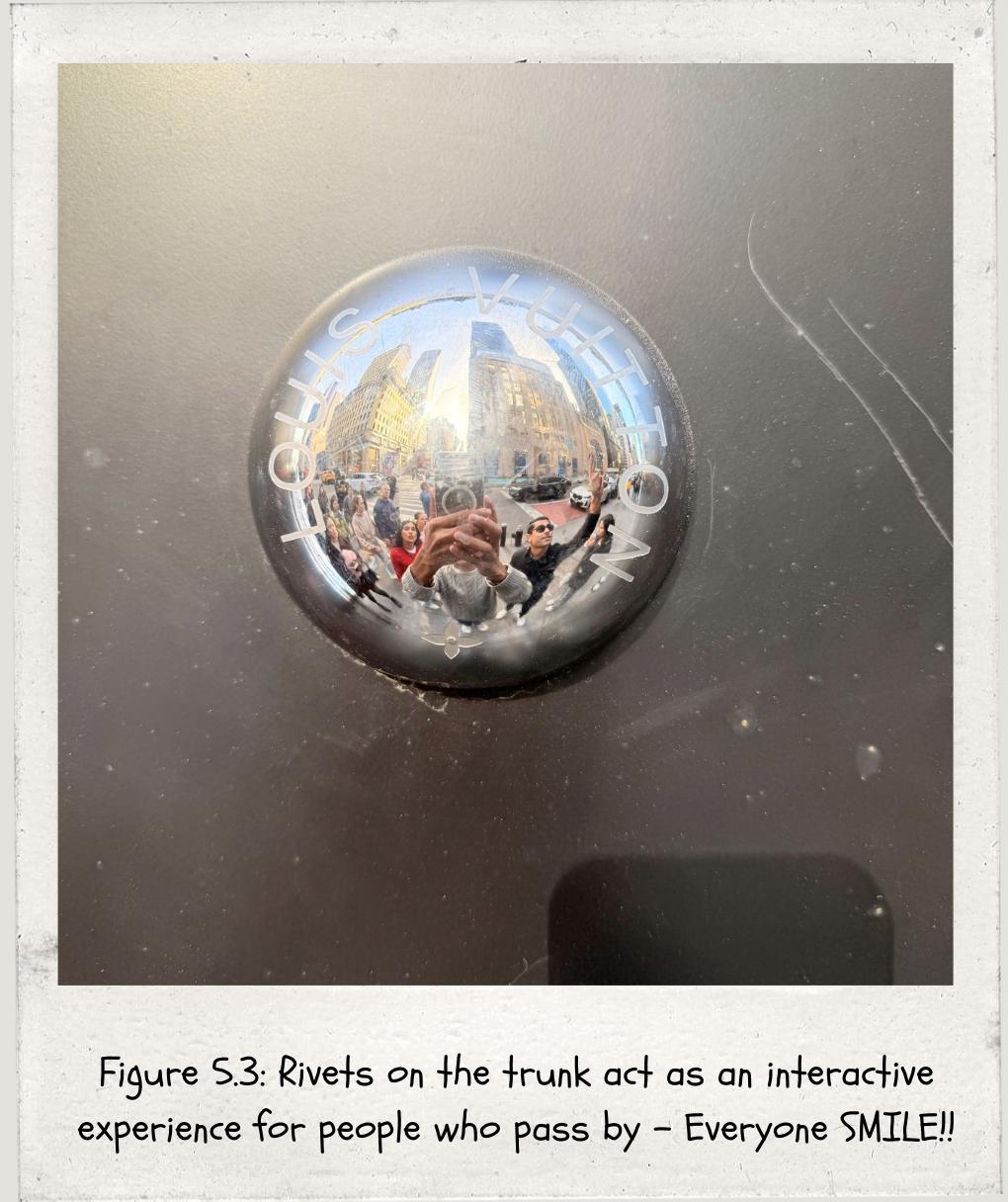
Once we finished taking in the grandeur, we asked ourselves, there must be another Louis Vuitton store available while the flagship is under construction. Walking down 57th street my brother spots both a large giraffe and ostrich on the facade of a building which indeed marked the temporary store. Designed by OMA (Office for Metropolitan Architecture), this multi-floor store inhabits both menswear and womenswear, a chocolate shop and the brands first U.S Louis Vuitton cafe. This space invites visitors into a curated Louis Vuitton experience, redefining the typical retail interaction. Upon entry, you are faced with four towering structures that span from the first floor soaring 16 meters. These installations are composed of heritage Courrier Lozine 90 trunks that evoke New York’s verticality, while simultaneously infusing detailed craftsmanship and innovation. Designed by OMA partner Shohei Shigematsu, each tower highlights the evolution of brand monograms such as the Damier Azur and metallic monogram . It can also be seen that the mirror bags are stacked in a brick-like format that create a 6 sculptural wall reflecting store activities. This elevated level of rhythmic interplay through materials and design invite the public to connect with Louis Vuitton and participate in the cultural narrative. For the first time in a while, I think my experience in this store directly correlates to my definition of luxury as stated earlier in this essay.
I also think it is worth adding that to truly understand a companies identity, you have to familiarize yourself with the company it keeps; it’s collaborators and creative partnerships. When coming into view of the fragrances, I notice a few bottles with a crinkled aluminum cap almost illustrating a blossoming flower (Figure 6.2). An employee gracefully approaches and begins to fuel my mind with knowledge about the design, and all I can do is sit like a sponge and absorb. This bottle was created by Frank Gehry inspired by his love for sailing and the visual movement of sails in the wind. The Louis Vuitton Foundation in Paris was designed by Gehry as well and

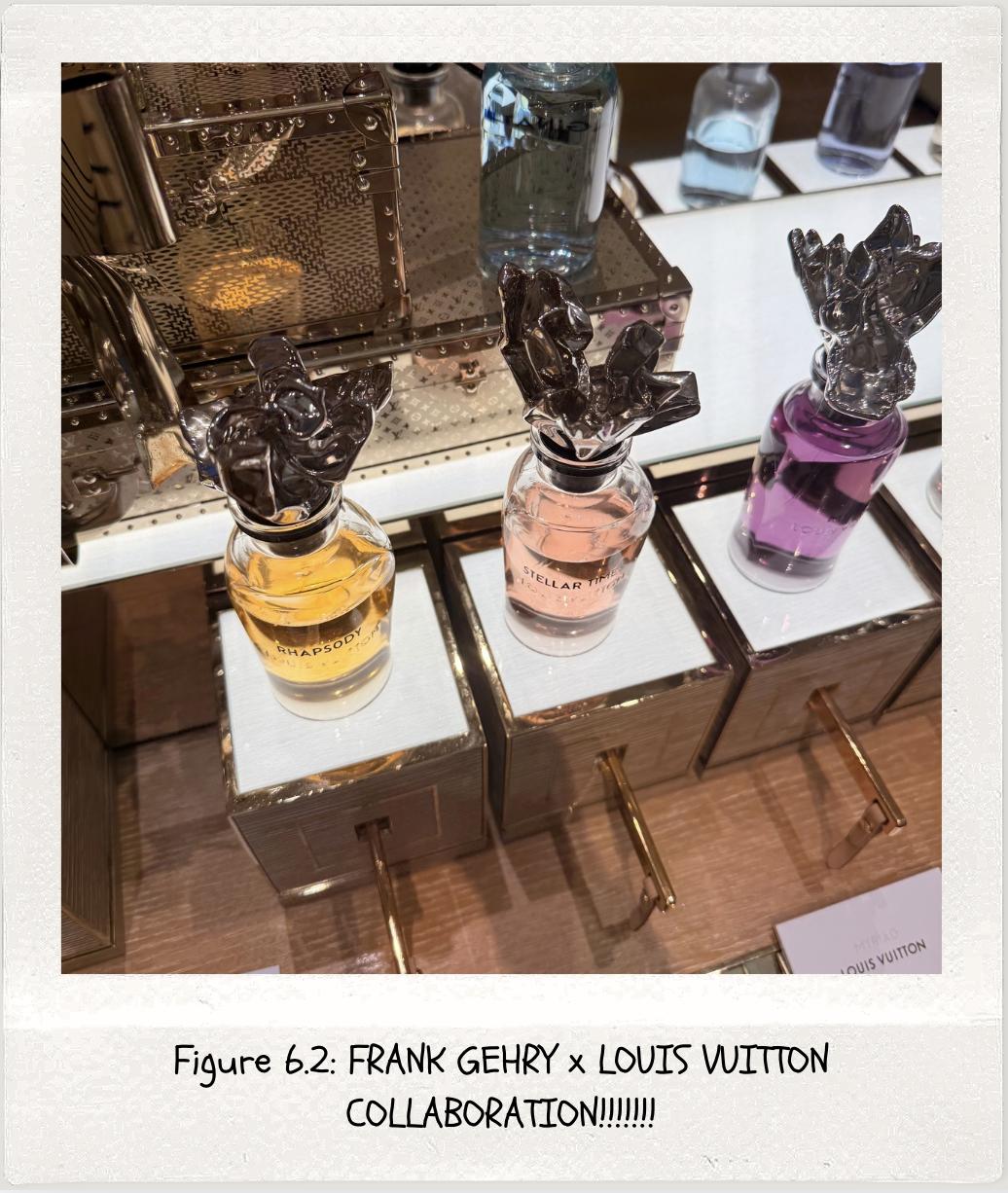
utilizes the same characterizations of curving glass panels resembling the sails . This was a full circle 7 moment as I have an image of this structure in my bedroom at home and to be made aware that this perfume bottle drew inspiration from it, imprinted a new level of engagement with the brand. The juxtaposition of the cap with the rounded glass base underscores fluidity and ephemerality. When the public interacts with product displays that showcase collaborations as such, there is a deeper connection offered where consumers engage with craftsmanship and artistic dialogue.
Our Louis Vuitton store in Toronto reflects similar elements of the brands architectural motifs such as monogrammed screens and curated interiors, however it falls short in providing the immersive consumer experience seen in its New York counterpart. Elements like a café invite consumers to pursue a connection beyond purchasing where as in contrast to Toronto, the store primarily functions as a transactional environment, offering minimal immersion for Canadian consumers. When being excluded from the opportunity to experience the Louis Vuitton narrative, it is suggested that the integration of leisure and lifestyle within this sector of the luxury industry remains underdeveloped in Canada, more specifically the district of BloorYorkville.
Engagement Analytics:

The Business of Fashion (BoF) is a global platform offering agenda-setting intelligence, analysis, and advice for the fashion industry. Founded by Imran Amed, he has worked to develop the BoF Brand Magic Index which evaluates the effectiveness of fashion brands in building strong relationships with its customers. Through a collaboration with Quilt.AI, BoF analyzes millions of data points across three equally-weighted metrics known as “1. Alignment: how clear a brand is to customers, as measured by analysis of brand and user-generated content on Instagram, TikTok and YouTube 2. Engagement: how effective a brand is in inspiring customers, as measured by customer behaviour on Instagram and TikTok and 3. Intent: how effective a brand is in driving action among customers, as measured by search volume on Google and Baidu. ” While Louis Vuitton ranked second on 8 Volume 2 of the Brand Magic Index, it placed 15th in “alignment” in comparison to Figure 8 counterparts; suggesting opportunities for improvement in narrative clarity and customer understanding of it’s brand identity. While alignment was measured through user-generated content, I believe there is a strong connection between enhancing the consumer experience and deepening their understanding of a brand’s identity. In New York, public perception of Louis Vuitton seems to improve when people are invited to engage with the brand's world beyond Finney, Alice. 2022
simply making a purchase. These spaces often serve as architectural backdrops for countless social media posts and stories, amplifying their cultural impact. By creating more environments where both global and local audiences can immerse themselves in the brand’s atmosphere and experiences, I believe Louis Vuitton could achieve an even greater alignment with its consumers.
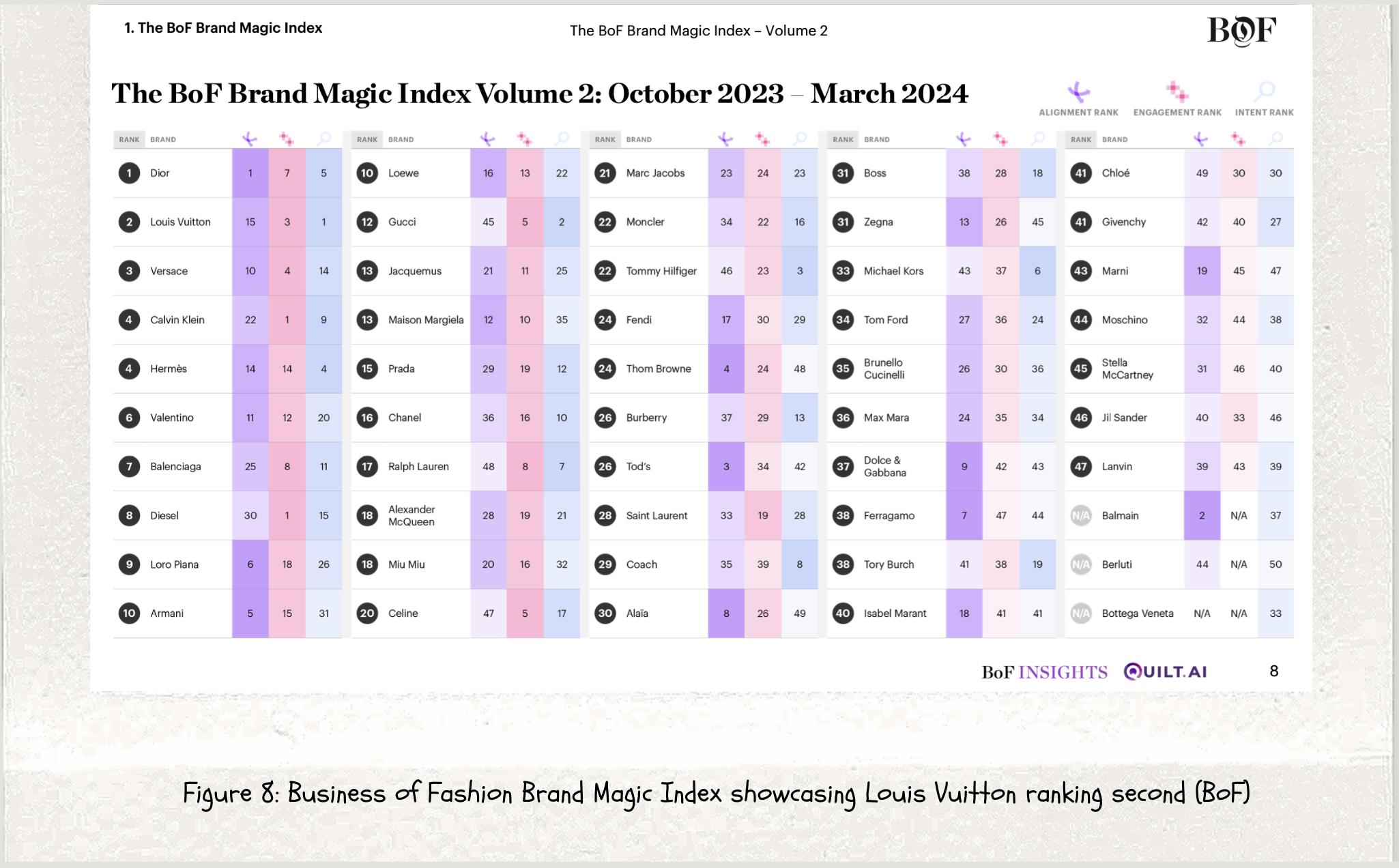
This emphasis on creating experiential spaces highlights a shift in how fashion districts function. They are no longer places to just shop but rather are areas that blend luxury with leisure and public engagement. LVMH ((Louis Vuitton, Möet Hennessy) Louis Vuitton’s parent company)) have projected that the current consumer begins buying luxury items at age 15 . Consumers of Generation Z and Generation Alpha are interested in 9 memorable experiences beyond purchasing. Digital channels already make it incredibly easy to purchase so when consumers enter a retail store location, there is a huge opportunity to transport and tell a story that elevates their experience.
Sustainability in Urban Luxury Design:
It’s no coincidence that walking out of the temporary Louis Vuitton store, I find myself drawn toward yet another gem of the district. This intersection feels like a heartbeat of Fifth Avenue, home to four iconic brands. After already experiencing Bulgari’s timeless elegance and Louis Vuitton’s world trunks; now, just ahead, Van Cleef & Arpels and Tiffany & Co. gleam like treasures waiting to be uncovered. My brothers and I cross the street weaving through the crowd and become distracted when Central Park comes into view. The contrast of sprawling greenery to towering cityscapes that make up the district pull our attention. I start think about how cities with this landscape operate in a world where there is a growing demand for sustainability. Can luxury and environmental responsibility coexist? It is difficult to ignore this when climate action should be at the forefront of Pringle, Eleanor.
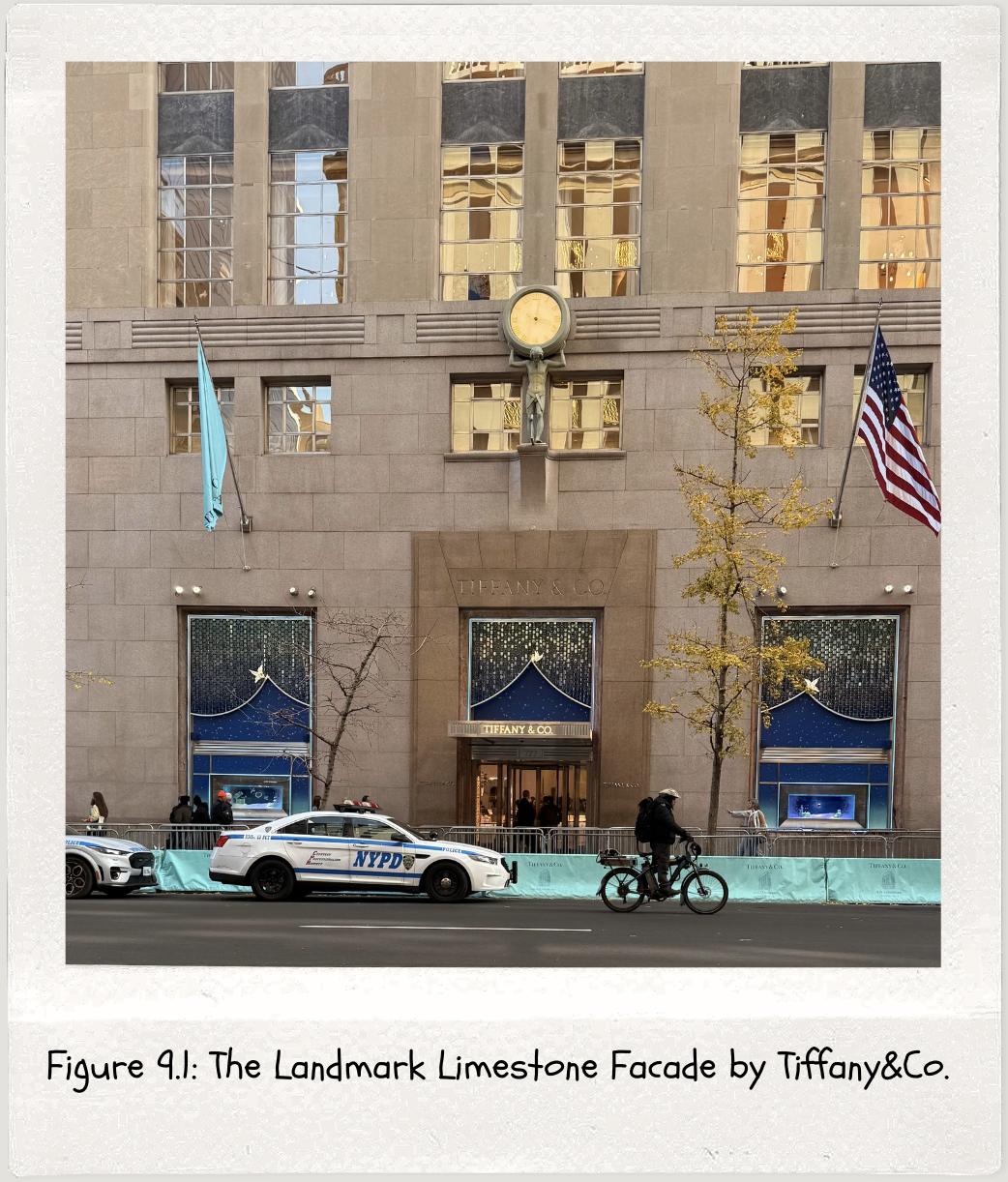

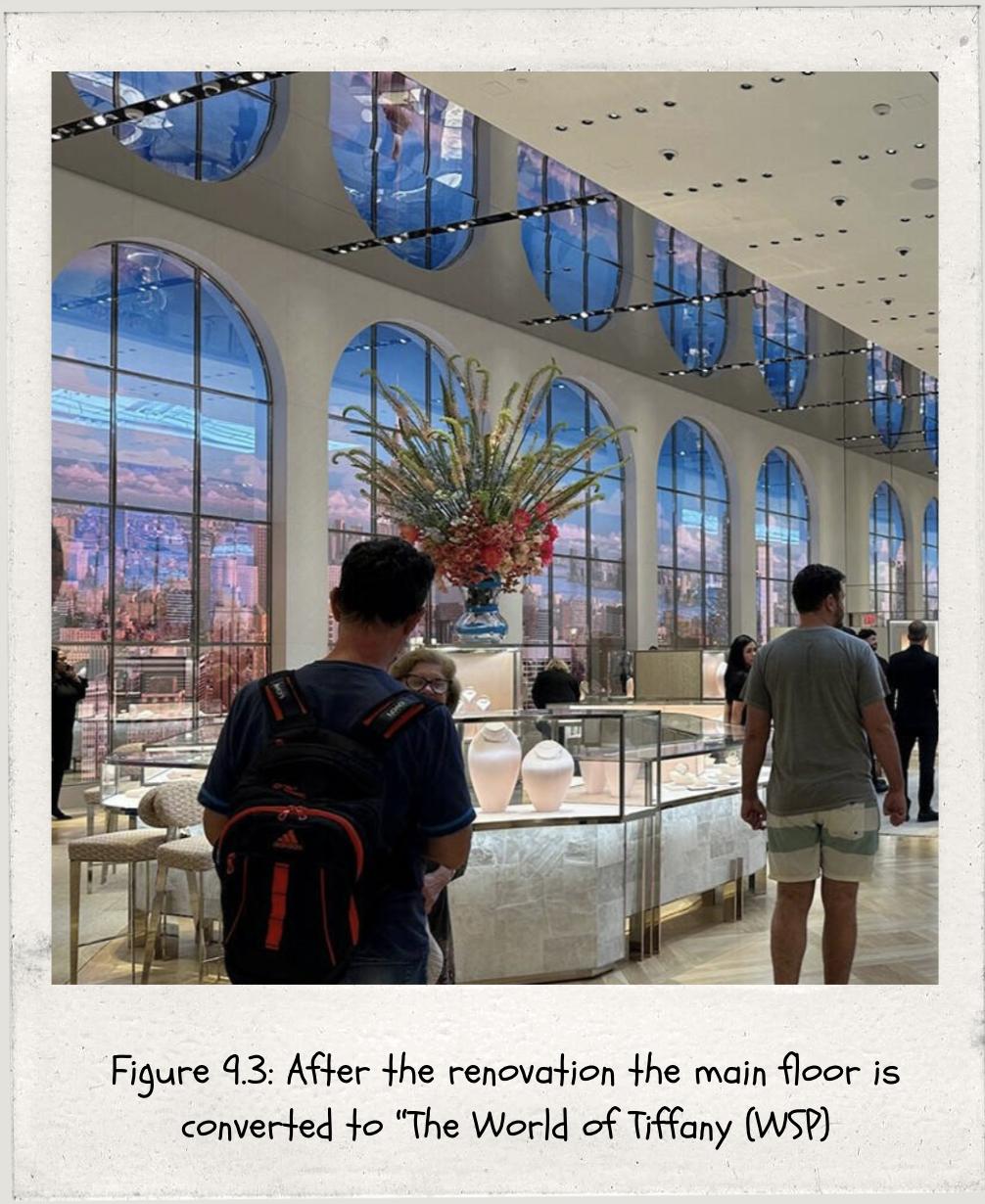
almost everything we do. By the time the cars start to accelerate, we finish crossing and are standing in front of Tiffany&Co’s facade that feels like an answer waiting to unfold.
“The Landmark” also known as the new Tiffany&Co flagship, is the first renovation to occur since opening in 1940 taking over 4 years to complete. Massing over 100,000 square feet, The Landmark infuses sustainability with luxury . Reed Krakoff, Creative Director of Tiffany&Co collaborated with OMA to reimagine what this 10 destination could mean for Manhattan as a whole. Krakoff emphasizes the need to be “transported into the extraordinary world of Tiffany [while] experiencing moments throughout the flagship that draw you up and around each floor… encouraging a journey of discovery. ”The redesign utilizes energy efficient, low emissivity glass on 11 floors higher floors and restores the original granite and limestone from the original facade created 83 years ago.



The focal point of the main floor titled “World of Tiffany” is composed of a 22 foot diamond shaped skylight designed and engineered by Hugh Dutton and Peter Marino. The skylight chandelier celebrates sustainability through its Bohemian crystal technique that reflects light to mimic the sparkle of diamonds and it’s kinetic abilities to adapt to consumer movements around the floor . Through the optimization of natural light from the skylight 12

above, there is a reduced need for artificial lighting placing further emphasis on the intricate craftsmanship involved, thus Tiffanys alignment to creating a more sustainable experience. While Tiffany&Co. on Bloor Street has yet to see a revitalization since 2013, the brand has shown its commitment to their Canadian consumers through their monumental redesign in Yorkdale Mall. Designed by firm SANAA, the exterior facade features 32,000 glass bricks that resemble the shift from a diamonds natural state into timeless jewellery . Amidst the main foyer, Dutton has integrated a 13 similar light sculpture as seen at The Landmark, however this one illustrates Canada’s national symbol, the maple leaf. As Tiffany continues to invest in architecturally sustainable and refined projects globally, their customers become more informed and part of the journey.

Users like myself begin to learn through experience how the brand aligns with sustainable practices. The Landmark has invested in extensive carbon reduction measures seen through rainwater harvesting, imbedding 100% renewable electricity into the site and also receiving numerous certifications acknowledging this comment such as WELL Platinum . Additionally, Tiffany&Co has made their commitment to sustainability since 14 1995 digitally accessible with emphasis on sourcing of their materials. The current day consumer is more interested in investing in sustainable practices for our earth and when met with a brand that not only recognizes it but has implemented actionable items, there is a stronger bond between consumer and brand identity, therefore enhancing the fashion district as a whole.


Conclusion:
As we make our way to the metro, passing through the concrete jungle one last time, I feel a lingering sense of curiosity and a deeper appreciation for the spaces I’ve explored. When thoughtfully designed, retail storefronts and interiors can transcend ordinary commerce. By shaping public experience, a journey is created unique to each individual. These atmospheres become areas where architecture and branding craft cultural landscapes that embody the shifting priorities of today’s consumer; one where sustainability, inclusivity, and luxury converge. Although many these companies are owned LVMH, there is almost a collaborative nature involved in the development of these districts. As seen in Figure 11.1 and 11.2, these stores follow a geometry that allows the journey to continue from store to store. They become the jewel of their districts both architecturally and culturally.
Walking down the subway steps, the air is heavy with the city’s pulse, yet my sense of smell drifts back to the scent I encountered at Dior earlier today. It wasn’t just a fragrance; it was an invitation to pause, immerse, and connect. In the same way, Fifth Avenue and Bloor Yorkville invite us to consider what they represent. Not just the luxuriousness on display, but the stories, values, and visions of a more interconnected future. And just like Lucky Eau de Parfum, these moments linger, shaping our perceptions long after we have departed.
Bibliography
1. “Bulgari Bloor Street West.” n.d. Bulgari. https://www.bulgari.com/en-int/storelocator/country-region/canada/on/toronto/131bloor-street-west?srsltid=AfmBOoppTBCF0xEyLtCiUaGL8jm8NZIP8SfMhIz5JG3y8T41Brc6BLIF.
2. “Diamond Skylight Chandelier | HDA.” n.d. https://www.hda-paris.com/project/diamond-skylight-chandelier/.
3. Eberhardt, Ellen, 2024. “Louis Vuitton Flagship Store Disguised as Stack of Luggage Trunks.” Dezeen, December 10, 2024. https://www.dezeen.com/2024/11/18/louis-vuitton-flagship-construction-disguised-stack-luggage-trunks/.
4. Fazzare, Elizabeth. 2020. “OMA And Tiffany & Co. Reveal Renovation of Fifth Avenue Flagship.” Architectural Digest, August 24, 2020. https://www.architecturaldigest.com/story/oma-reveals-renovation-tiffany-fifth-avenue-flagship.
5. Finney, Alice. 2022. “Frank Gehry Tops Louis Vuitton Perfume Bottle With Aluminium Flower.” Dezeen, February 3, 2022. https://www.dezeen.com/2021/10/08/frank-gehry-louis-vuitton-perfume-bottle-les-extraits/.
6. Intner, Katie. 2024. “Fragrance and Lipstick Lovers Rejoice! Dior Opens Its First Beauty Boutique in New York City.” Harper’s BAZAAR, November 1, 2024. https://www.harpersbazaar.com/beauty/makeup/a62778539/dior-beauty-store-opening-newyork-city/.
7. “JUNE Annual Conference.” Journal - American Water Works Association 99, no. 5 (2007): 61-.
8. “Louis Vuitton 57th Street NYC.” n.d. OMA. https://www.oma.com/projects/shigematsu-louis-vuitton-57th-street-nyc.
9. “OMA.” n.d. OMA. https://www.oma.com/projects/shigematsu-louis-vuitton-57th-street-nyc.
10.Magazine, Magnifissance. 2024. “Luxury Brand Bvlgari Opens New Flagship Boutique in Toronto.” Magnifissance. June 25, 2024. https://magnifissance.com/style/bvlgari-new-flagship-toronto/.
11.Moin, David. 2017. "Business: Bulgari Reopens on Fifth Avenue: The Ornately Designed Flagship Brings both an Artistic and Roman Expression to Fifth Avenue." Wwd (Oct 06): 4. http://myaccess.library.utoronto.ca/login? qurl=https%3A%2F%2Fwww.proquest.com%2Ftrade-journals%2Fbusiness-bulgari-reopens-on-fifthavenue%2Fdocview%2F2196320932%2Fse-2%3Faccountid%3D14771.
12.Patterson, Craig. 2024. “Luxury Jeweller Bulgari Unveils Canadian Flagship Store on Bloor Street in Toronto [Photos].” Retail Insider, June 13, 2024. https://retail-insider.com/retail-insider/2024/06/luxury-jeweller-bulgari-unveils-canadian-flagship-storeon-bloor-street-in-toronto-photos/.
13.Petterson, Craig. 2024. “Tiffany&Co. Overhauls Yorkdale Flagship With Stunning Redesign.” Retail Insider. November 27, 2024. https://retail-insider.com/retail-insider/2024/11/tiffany-co-overhauls-yorkdale-flagship-with-stunning-redesign/.
14.Pringle, Eleanor. 2023. “Gen Z Are Splurging on Luxury Shopping From as Young as 15.” Fortune. January 18, 2023. https:// fortune.com/2023/01/18/gen-z-are-starting-to-splurge-on-luxury-shopping-as-young-as-15-up-to-5-years-earlier-than-theirmillennial-counterparts-did/.
15.Storefronts Show Advantage of Curb Appeal. Chain Store Age (1995). Vol. 72. Chicago: Lebhar-Friedman, Inc, 1996.
16.“The BoF Brand Magic Index – Volume 2.” n.d. Report. The BoF Brand Magic Index – Volume 2. https:// cdn.businessoffashion.com/reports/The-BoF-Brand-Magic-Index-Volume-Two-Preview.pdf.
17.“Tiffany Fifth Avenue Landmark Sustainability Design | Tiffany & Co. US.” n.d. https://www.tiffany.com/stories/tiffany-fifthavenue-landmark-sustainability-design/.
18.“WSP - Tiffany & Co.:Restoring the Brilliance of an Iconic Crown Jewel.” n.d. WSP. https://www.wsp.com/en-us/insights/2023tiffany-flagship-store-reopens-reimagined.
